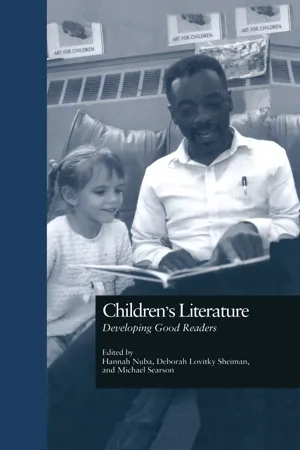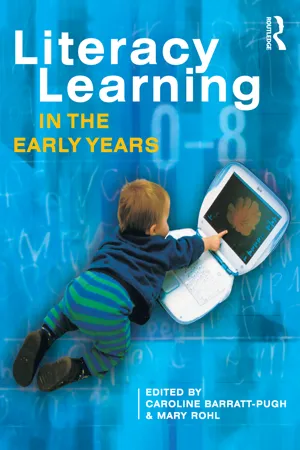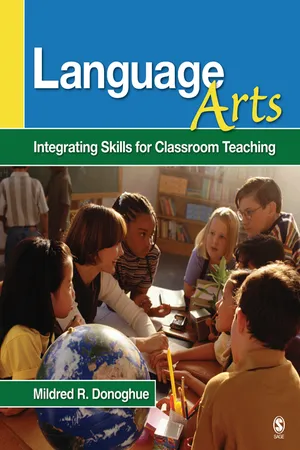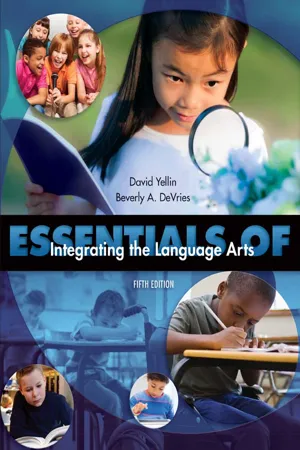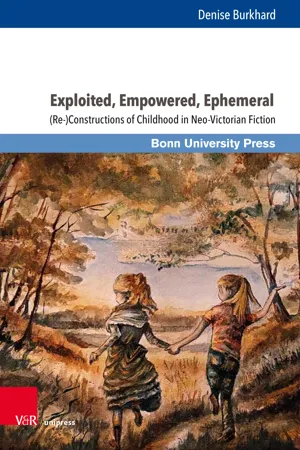Literature
Children's Fiction
Children's fiction refers to literature specifically written for and targeted at children. It encompasses a wide range of genres, including picture books, chapter books, and young adult novels. Children's fiction often addresses themes and issues relevant to young readers, and it plays a crucial role in fostering imagination, empathy, and literacy skills in children.
Written by Perlego with AI-assistance
Related key terms
1 of 5
5 Key excerpts on "Children's Fiction"
- eBook - ePub
Children's Literature
Developing Good Readers
- Hannah Nuba, Michael Searson, Deborah Lovitky Sheiman(Authors)
- 2013(Publication Date)
- Routledge(Publisher)
The selection of a good children’s book is similar to the selection of a good adult book. In both, the reader is searching for qualities basic to good writing. For an adult scouting the stacks of the library, this search may be as difficult as thumbing through hundreds of children’s books or as quick and easy as asking the town librarian for a recommendation. Most communities have experienced children’s librarians who are happy to help select a well-written, interesting, and appropriate book. Also, prepared reading lists are often available to facilitate selection. Frequently these lists divide the books by age or grade. Topical lists can be helpful in finding just the right book for a particular occasion.Stretching a child’s imagination through literature kindles creative thought. However, a word of warning is appropriate. Sometimes very young children have a blurred conception of reality and fantasy. Their egocentric thought process colors the boundaries between what is real and what is make-believe. The younger the children are, the more likely they are to perceive fantasy as truth.Fantasy can be beneficial in that it allows the child to rehearse life events before they take place. Mentally practicing a new or frightening situation enables the child to enter the experience with less anxiety. However, defying the natural role of fantasy and mistaking it for reality can lead to dangerous situations and serious consequences. The fictitious Jack might be able to climb to the top of the beanstalk without repercussions, but little Jimmy should not climb to the top of a tree unsupervised, for he just might fall. It is therefore extremely important to select literature that fits the developmental level of the child and to remind young ones that the story being read is fictitious—an invention of the author’s imagination.Consumers of children’s books are aware of the specific qualities inherent in well-written juvenile literature. Any good book, whether written for adults or children, needs convincing, credible characters. Children, like their grown-up counterparts, more readily relate to characters with believable personality traits.Children’s books often use animals portrayed as humanlike in their actions, emotions, and experiences. This is neither peculiar nor confusing to a young child. Although the use of an animal figure represents creative fancy, its given traits must still be convincing. The child must be able to connect with the character. Beatrix Potter’s Peter Rabbit stories (first published in the United States in 1934) are still fine examples of animals displaying humanlike idiosyncrasies and traits in a humorous and exaggerated style. Good literature, like Beatrix Potter’s, creates memorable characters that juggle the elements of reality, stretch the child’s imagination, and provide enjoyable reading for both child and adult. - eBook - ePub
- Caroline Barratt-Pugh, Mary Rohl(Authors)
- 2020(Publication Date)
- Routledge(Publisher)
Literature goes beyond stories that are told in words and which are written down as books. Literature is expressed in many ways: in picture books, all forms of art, television, films, plays, musicals, dance, interactive computer programs, classical and pop music, and so on. Different cultures may express stories in different forms. For example, a culture that does not include writing, such as early Aboriginal cultures, may express stories through dance and music (Cusworth & Simons 1997). These stories are all part of a body of literature that has popularly appealed to children and to adults who want to share vicarious experiences with children.Until late last century there was no specific body of literature that was specifically designed for children, except for collections of 'cautionary tales' which were expected to promote good manners and high standards of morality. Apart from these tales, children read books that were generally available to adult audiences. Often very few books were available to children and they learnt to read from any resources available, such as The Bible or, as shown in the movie My Brilliant Career, from newspapers which papered the walls of their houses.Much literature that is popularly thought to be appropriate for children is derived from folk tales and often carries mature and sometimes sombre messages. Fairy tales from Grimm and Flans Anderson are examples of folk tales that have comparatively recently become identified as stories suitable for children. The story of 'Flansel and Gretel' (Briggs 1974), for example, is a story of family betrayal, child abuse, deception of children by a supposedly caring adult, with a violent death as a solution to evil. These are powerful ideas for adults, let alone young children. The story is also one of heroism which demonstrates the power of children to overcome problems in the world of adults and defeat the powers of evil, and it concludes with a satisfying family reconciliation. For all its cruelty, the story has always been popular, and has been retold in many forms, from opera, ballet, pantomime, music and art, to a range of picture books. Anthony Browne's picture book version of Hansel and Gretel (Browne 1981) is one of the best-known picture book versions of the story. This book works on several levels through the interaction of the written text and visual illustration of the story. The literal level or level of the events in the story is clear, but there is also a deeper level, or thematic level, where there are messages that are clear to mature readers which may be perceived intuitively by children. The use of this version oí Hansel and Gretel (Browne 1981) is elaborated by O'Brien and Comber in Chapter 7 - eBook - PDF
Language Arts
Integrating Skills for Classroom Teaching
- Mildred R. Donoghue(Author)
- 2008(Publication Date)
- SAGE Publications, Inc(Publisher)
Other criteria are discussed in the next section. 208 Part II Reading as a Language Art Elements of Literature While children read both fiction and nonfiction books, each category requires different elements to qualify as literature. Elements of Fiction Students’ reading will not be limited to stories, but these will remain the first and enduring favorite with girls and boys. Good stories possess six strong elements: 1. Plot: Children are most interested in the action or what happens in the story. In a well- written book, the action is plausible and credible, developing naturally from the behavior and decisions of the characters. It does not depend on coincidence or contrivance. A story must have a beginning, middle, and end. Students prefer a chronological plot with an orderly sequence of events such as in Curtis’s Bud, Not Buddy (1999 ). Flashbacks are another type of plot device found mostly in chapter books for older readers such as George’s My Side of the Mountain (1988) since students generally lack the maturity to understand flashbacks until about age 10. Briefly, the story plot has been described by Sawyer (2000) as “a kind of road map” to that story. Teachers should avoid books with stories that have no conflict and no suspense, pre-dictable stories, stories that are overly sentimental or full of events that appear to occur merely by chance, and stories with endings that do not solve all the problems presented (Sharp, 1997). 2. Characterization: The personalities (animal or human) portrayed in children’s books must be convincing and lifelike, must display realistic strengths and weaknesses, and must be consistent in their representation. Though not every character in a well-constructed story will change, there is frequent personality development as happenings occur and problems are solved. Also, characters should speak and behave in accordance with their culture, age, and educational experience. - eBook - ePub
- David Yellin(Author)
- 2017(Publication Date)
- Routledge(Publisher)
Children’s and young adult literature comes in many formats, including hardcover books, ebooks, magazines, comics, graphic novels; we may also include audio recordings, films, videos, and online interactive and computer adaptations of popular stories. Peggy Parish, the author of the popular Amelia Bedelia series, stated in regard to writing children’s literature that “first you have to know what is of interest to children. … You have to make every word count. Also, in order to capture and hold a child’s attention, there has to be a certain rhythm and flow in a story which complements its essential simplicity” (p. 25). Her point is that writing for children is a specialized form of communication and no easy task. Christopher Paul Curtis, author of award-winning young adult books, including Bud, Not Buddy (1999), has a somewhat different perspective. When asked why he wrote for young adults instead of adults, he explained: “I think that a good story can be read by anybody. If the story is compelling and interesting, it can be read by children and adults. I don’t really differentiate that much.” When asked what his favorite book was as a child, he replied: I didn’t have books that I really loved as a child. I read comic books, MAD Magazine, National Geographic, and Sports Illustrated. I read a lot, but books didn’t really touch me, probably because there weren’t a lot of books for or about young black children. That’s not to say that blacks have to read “black” books, but you do need to read something that really touches you to develop that love for books. (New York Public Library, 2002) We as teachers can learn from Curtis. It is important to help students of all ages select books with which they can identify. We must also give students access to magazines, comic books, and texts in other formats - eBook - PDF
Exploited, Empowered, Ephemeral
(Re-)Constructions of Childhood in Neo-Victorian Fiction
- Denise Burkhard(Author)
- 2023(Publication Date)
- V&R Unipress(Publisher)
“Imagining the Child.”, 17. 69 Alan Richardson. Literature, Education, and Romanticism, 117. 70 Alan Richardson. Literature, Education, and Romanticism, 114. 71 The strong focus on instruction and didacticism in literature for children fostered the emergence of critical voices that considered the fairy tale as inappropriate reading material for children. Drawing on Samuel F. Pickering, Alan Richardson observes that both fairy tales and fantasy “came under attack from two sides: the rationalist school of education drawing on Locke and Rousseau, and (although with notably less consistency) the Christian moralist critique of children’s fiction which found exponents in writers like Sarah Trimmer and M.M. Sherwood”. Alan Richardson. Literature, Education, and Romanticism, 113. In spite of this criticism, the fairy tale continued to be read and published widely. 72 Matthew Grenby. “Children’s Literature: Birth, Infancy, Maturity.”, 53. 73 M.O. Grenby. The Child Reader, 1700–1840, 109. The dual audience of the Grimms’ fairy tales is implicit in its original German title: Kinder- und Hausmärchen (transl. Children’s and Household Tales). Children and Childhood 52 © 2023 V&R unipress | Brill Deutschland GmbH ISBN Print: 9783847116042 – ISBN E-Book: 9783847016045 often under the aegis of religious societies, and the nineteenth century was the heyday of textbooks full of facts to be learned by rote” 74 . Nonetheless, the commercialisation of children’s literature, which contributed significantly to the recognition of children as readers in their own right, fostered a more varied repertory of children’s books available on the book market and paved the way for “the fantastical [becoming] more central to children’s literature” 75 at the be- ginning of the nineteenth century.
Index pages curate the most relevant extracts from our library of academic textbooks. They’ve been created using an in-house natural language model (NLM), each adding context and meaning to key research topics.
